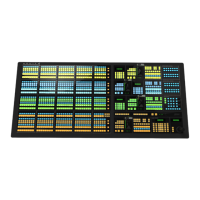Memory Functions
A memory register is a snapshot of the current state of
the switcher that can include multiple MEs. Up to 1,000
memory registers per ME can be stored and recalled on
the switcher. Each of these memory registers can store
as little as the information of one ME, or as much as the
current state of the entire switcher, including all MEs,
Aux Buses, and DVE settings.
Keep the following in mind:
Keep the following in mind when working with
memories:
• Memories are stored in groups, or banks, that
correspond to the rst two numbers in the memory.
For example, Memory039 is Memory 9 in Bank 03.
The available slots for memories range from Memory
0 on Bank 00 through to Memory 9 on Bank 99.
• You can override the video source stored in a memory
by pressing and holding a source button and recalling
the memory (Bus Hold). The held source button
overrides the source that is recalled with the memory
for that bus. The memory is not affected by a Bus
Hold and will recall properly without the Bus Hold.
• The Keys Only (KEYS ONLY) button allows you
to recall a memory on a panel row that does not
include the Program and Preset bus selection. Only
the keyer selections are recalled. The Global-Store
image selections stored in the memory are not loaded
if the Recall Global-Store personality option is set to
Attribute.
• The Effects Dissolve (EFF DISS) button allows you
to have the keys from one memory slew into the keys
from the one you are recalling.
• The +4 buttons allows you to select an ME above
ME 4. When the +4 button is toggled on, the ME 1
through ME 4 buttons become ME 5 through ME 8
buttons, respectively. For example, if you want to
select ME 6, toggle the +4 button on, and press ME
2. Both the ME 2 and +4 buttons will remain lit.
• The Undo (UNDO) button allows you to take back,
or undo, the last memory recall. This returns the
switcher to the state it was in prior to the last memory
recall. The Undo button lights up after each memory
recall, indicating that the action can be undone. If
you perform 10 or more button presses after the
memory recall, the Undo button goes out, and the
memory can no longer be recalled.
• The Attributes (ATTRIB) button allows you to view
the ME Memory Attributes menu, or override the
attributes stored with the memory. To override
attributes, press and hold the ATTRIB button while
recalling the memory.
• The Recall Empty Memory personality option can
prevent memories that are empty, deleted, or marked
as Don't Recall from being recalled.
Storing Memories
When you store a memory, you are storing the complete
state of that panel row. This includes the current state of
all the areas on the ME, including keyer settings,
transition rates, wipe and pattern selections, and
crosspoint selections. In addition to the current state of
the panel, the current settings for the various keyers, such
as chroma key settings, and clip and gain settings, are
also stored.
To Store a Memory
1. Press the ME buttons on the Store side of the Global
Memory module for the MEs you want to store a
memory to.
• ME X — the ME(s) you want to store the
memory to. Press and hold the ME X button for
the rst ME you want to include and then press
the other ME X buttons to add MEs 1-4. Release
the other button and press and hold the +4 button
and then press the ME X buttons to add MEs 5-8.
• ALL — store memory to all MEs.
Tip: Press STORE on an Effect Memory module to only
store a memory to the ME that the panel row is assigned
to.
2. Press and hold BANK and press the number (00-99)
for the memory bank you want to store the memory
to.
Tip: If a memory has been stored to a register, the
corresponding button is lit. The button shows gray if the
memory register is empty. For example, if memories have
been stored to registers 1 and 5, buttons 1 and 5 are lit and
the buttons 0, 2-4, and 6-9 are gray.
3. Press the number (0-9) for the memory register you
want to store the memory to.
Tip: If the Auto Recall feature is turned Off, you cannot
store or recall the Effects Dissolve or Keys Only setting with
a memory.
4. Press ENTER to store the memory. You are
prompted to name the memory. This can be done
later.
Acuity Operation Manual (v9.2) — Memory Functions • 65

